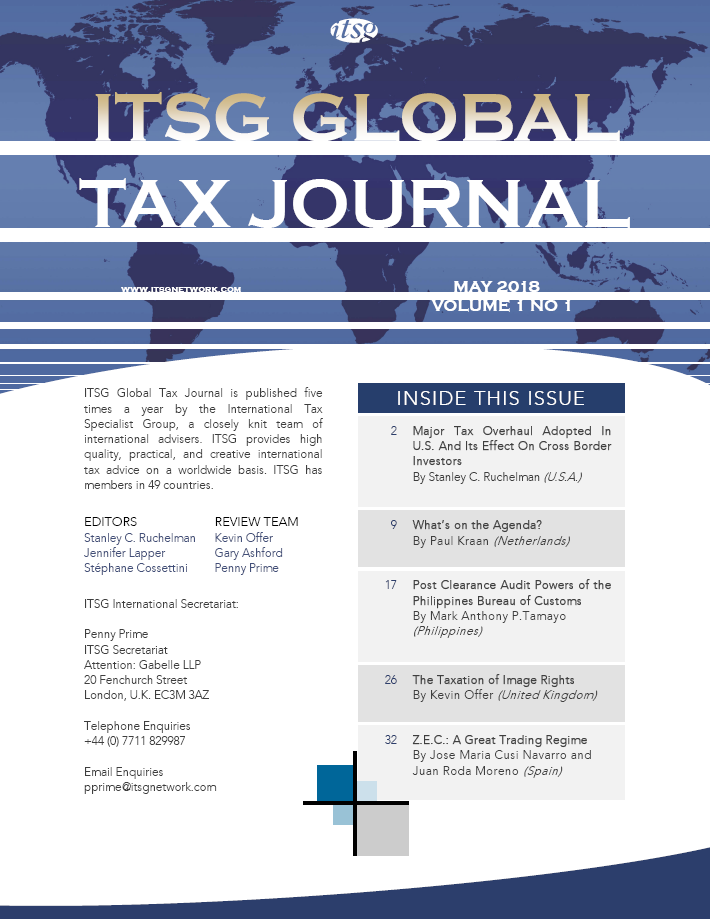Introduction
Last year’s revelations in the press from the so called “Paradise Papers”, a number of documents obtained from the hacking of the computer systems of a law firm and other related entities, has once again brought tax into the press. In addition, a number of high profile cases involving footballers in Spain and press reports in the U.K. have highlighted the use of structures for the exploitation of image rights. These tax planning arrangements, when implemented correctly, are usually legal so do not constitute evasion. However, in the current climate where, in the U.K., the distinction now appears to be drawn between tax planning and tax avoidance rather than avoidance and evasion, tax authorities and governments are under increasing pressure to clamp down on what was previously considered to be acceptable tax planning.
This article looks at the taxation of image rights associated with professional sportspersons with particular reference to the developments in the U.K. during 2017.
Image Rights Structures and Practice
When looking at image rights it is first necessary to define what constitutes an image right. The U.K. concept of an image right is actually a bundle of different intellectual property rights such as contractual rights, trademarks, copyrights, etc. Other countries may have different views as to whether an image right exists or there is a collection of rights, etc. For example, article 18.1 of the Spanish Constitution indicates that image rights are recognised alongside other personal rights, such as honour and privacy. In Guernsey (part of the Channel Islands) it is possible to register an individual’s image rights. The benefits of doing so remain to be seen but this may prove useful in support of any challenge as to the existence of an image right.
Image rights structures have been around for a number of years and their use has increased considerably. At a basic level an individual will assign or licence the right to exploit their image to a company. That company will then exploit the rights by entering into contracts with others. Depending upon the jurisdiction in which the company is located, the status of the individual and the contractual arrangements the profit generated by the company may then be taxed at a reduced rate or not at all. The tax savings can, therefore, be considerable.
The number of football players based in the U.K. setting up companies to exploit image rights has increased by around 80% in the past two years with more than 180 players in the English Premier League now appearing to have companies that may receive income from the exploitation of image rights. A little over 100 of those companies are reported to hold a total of £60m and are reported to have avoided at least £21m in tax1. Such companies can be used to provide pension type benefits or create a capital payment after retirement.
Image rights companies are particularly attractive to overseas players who can receive funds outside the U.K. after ceasing to play in the U.K. often without further taxes. Foreign players with an international earning potential may be able to set up a company outside the U.K. and take advantage of the U.K.’s non-domicile regime. This can allow payments for image rights, etc. that arise outside the U.K. to be paid to an offshore company without incurring any U.K. tax charge (subject to the Remittance Basis Charge). It is not uncommon, therefore, to see endorsement contracts to cover exploitation of a player’s image in certain areas of the world with the U.K. specifically excluded. Such companies may be set up in tax havens although the need for access to tax treaties and the reluctance of some sponsors to be associated with a company in a tax haven make this less likely. It is, however, still possible to have the best of both worlds by using structures such as the one it is suggested was set up for a well-known football manager which allowed a small amount of income to be taxed in Ireland at a rate of 12.5% with the balance flowing through to a company in a tax haven such as the British Virgin Islands.
With a growing number of such structures the payments to image rights companies was the subject of a challenge by H.M.R.C. in the U.K. during 2011. After lengthy negotiations it was believed by football clubs and their advisers that an agreement had been reached with H.M.R.C. in 2015 that allowed clubs to treat up to 20% of the salaries paid to players as a payment for the use of their image rights. Documents published as part of the football leaks revelations included an email from an adviser indicating that the position had been “agreed formally with the clubs” and that, although nothing would be formally published, all clubs had been provided with details of the agreement with H.M.R.C. However, when asked about these arrangements, H.M.R.C. denied agreeing any deal with the clubs in 2015. In early 2017 they stated that they are currently investigating more than 100 players over their use of “tax avoidance schemes”. This does not specifically mean that they are investigating image rights companies as it is known that a number of individual players are caught up within enquiries into other tax arrangements, but it can be concluded that image rights payments are included in the enquiries.
The use of image rights companies as highlighted in the football leaks papers led Meg Hillier, the Labour MP and chairperson of the House of Commons Public Accounts Committee, to say “I am frankly amazed that H.M.R.C. can seemingly rubber-stamp such a practice which, on the face of it, seems solely designed to minimise tax. Although this is legal it is certainly not in the spirit of the law”. This increasing pressure on H.M.R.C. to challenge such structures led to an announcement in the U.K. Budget statement in March 2017 that H.M.R.C. would “publish guidelines for employers who make payments of image rights to their employees to improve the clarity of the existing rules”.2
The exploitation of image rights arrangements has also been the subject of challenge in other countries. In Spain there have been some high-profile cases involving international football players and the application of what was understood to be the “15% safe harbour” regime. In the past it was understood that a split of 15/85 would not be challenged but, again, the perceived abuse of this regime and particularly aggressive tax avoidance arrangements have resulted in a level of uncertainty in dealing with the Spanish tax authorities with regard to image rights.
In the U.S.A. the approach of the tax authorities appears to be a little clearer even though, in practice, there may be some difficult negotiations required with the IRS. In the case of Retief Goosen3 the issue was how streams of income would be treated for US tax purposes. It was held that certain income streams would be allocated 50/50 to personal services and royalty income whilst other income streams were allocated to a US source based on the facts although treaty relief was not available.
Development in the Taxation of Image Rights
In July 2017 the Entertainment, Sports and Media Group of the I.C.A.E.W. in the U.K. published a document “Image rights – a whole new ball game”. This document set out the way in which image rights work in practice in the U.K. and the tax implications arising from such arrangements. It was identified that image rights had become an integral part of football and were part of the negotiations entered into whenever a player switched clubs or signed a new contract and that a club would often agree to pay a proportion of the salary to a player’s image rights company.
The tax benefits were indicated but the only issue identified within the document was the problem of valuing the image rights which, the author comments, was “subjective”.
Emphasis was placed on H.M.R.C.’s acceptance that image rights are separate after the Sports Club case4 and it is commented that the agreement with the 20% cap was a temporary arrangement for the 2016/17 season. What is not addressed in the document, however, is the question of whether payments made are actually for the exploitation of image rights or relate to an employment. For example, is a simple split of a salary within the 20%/80% agreement sufficient?
Could the Rangers case be applied?
The tax case involving Glasgow Rangers football club5 involved the use of trust arrangements to avoid tax on payments to employees. This has been a long running case in the U.K. with the final Supreme Court decision in favour of the H.M.R.C. being delivered on 5th July 2017. Within paragraph 39 of the decision, the court set out the principle that employment income paid from an employer to a third party is still taxable as employment income. H.M.R.C.’s view is that this principle applies to a wide range of “disguised remuneration tax avoidance schemes no matter what type of third party is used”. Guidance published on 29th September 2017 stated that H.M.R.C. intended to use the decision to take action against a number of schemes6. Whilst the guidance does not specifically refer to image rights structures it could be argued that payments made to an image rights company negotiated as part of the salary of a player could be challenged on these grounds.
This view appears to follow that of the Australian courts. In the long running case involving the Australian rules football club known as the Brisbane Lions7 the courts have concluded that payments to players and coaching staff for the use of image rights were taxable wages and therefore liable to payroll taxes.
H.M.R.C. Guidance
H.M.R.C. published additional guidance on image rights payments on 16th August 20178. The actual guidance document is very short and doesn’t actually contain much in the way of “guidance”. It is identified that payments for the use of an individual’s image rights can be taxed in different ways. The guidance then goes on to indicate that tax may be charged in one of three ways.
- Payments made to a self-employed individual are taxable as professional income.
- Payments to employees for the duties of an individual’s employment must be taxed as earnings subject to tax deductions at source and not as payments for the use of image rights. It is the employer’s obligation to ensure that deductions are made.
- Image rights payments made to a U.K. company will give rise to a liability to U.K. corporation tax on profits. Income received by the individual from their company is taxable in accordance with the type of income received (i.e. dividends, salary, etc.).
The guidance does not go into further detail but refers the reader to the H.M.R.C. Employment Income Manual9 which contains additional guidance on image rights payments10.
H.M.R.C. defines “image rights” as likely to be dependent upon a bundle of different rights. It is noted that image rights contracts are popular with sportspersons but are likely to allow for the exploitation of an individual’s public appearances, copyrights, trademarks, etc. as well as an individual’s name, likeness, etc. They do not accept that there is a single asset and it is therefore necessary to analyse the rights being exploited to determine the tax position.
The next section of the manual comments on payments to an image rights company (I.R.C.). It is noted that, in recent years, the assignment of an asset described as “image rights” to an I.R.C. has become common practice. However, in H.M.R.C.’s view, it is not correct to regard the transfer of a registered trademark, such as a person’s name, caricature, etc., as a transfer of “image rights”. It is noted that an individual may agree to perform services in connection with the “image rights” which are exploited by the I.R.C. resulting in the payment of royalties or license fees. The justification often quoted by advisers for arrangements such as this is the Sports Club case referred to above. H.M.R.C., however, note that this was a decision by the Special Commissioners published in anonymous form. As the Inland Revenue (the predecessor to H.M.R.C.) did not appeal this decision it did not proceed to the courts and H.M.R.C. therefore regard the decision as “informative rather than having created precedent”11. This leads to the conclusion that the Sports Club case cannot be relied upon and that other factors need to be considered before H.M.R.C. will accept an I.R.C. is effective for tax purposes.
The Sports Club case
The Special Commissioners when considering the Sports Club case recognised there was no property in a person’s image and the description of the arrangements in the case as “image rights agreements” was misleading. The arrangements were therefore referred to as “promotional agreements”. These promotional agreements led to payments being made to the I.R.C.’s of the two players involved by the club in respect of promotional services provided by the players.
The case before the Special Commissioners was whether the payments were earnings from the employment of the players by the club (and so chargeable to income tax as employment income) or, if not, benefits in kind (and so treated as earnings from the employment). In order to consider these points, the following questions were identified.
- Did the promotional agreements have independent values?
- Were the promotional agreements a “smokescreen” for additional remuneration?
- Were the payments under the agreements emoluments from the employments?
The Special Commissioners decided that the promotional agreements were capable of and did have independent values and were genuine commercial agreements. As a result, in light of the specific facts of the case, the payments were not earnings from the employment with the club.
The Special Commissioners also decided that a “benefit” cannot include something in return for “good consideration under a separate commercial contract”. The payments were not, therefore, benefits in kind and should not be regarded as earnings of employment.
H.M.R.C., whilst accepting the decision, consider that it is based on the specific facts and should not be regarded as a precedent to justify the arrangements of other taxpayers. H.M.R.C. will still consider whether the payments to an I.R.C. should be regarded as income arising from an employment. The decision in the Rangers case may assist H.M.R.C. with this argument in future cases. The Brisbane Lions case, while having no jurisprudence in the U.K., may also assist in forming H.M.R.C.’s views.
Other H.M.R.C. guidance
H.M.R.C. have also provided their views on whether deduction of tax should be made from payments made to an I.R.C. Royalties and other income arising from intellectual property which has a source in the U.K. are liable to U.K. income tax12. H.M.R.C. believe some of the intellectual property rights that form the image rights assigned to an I.R.C. will meet the definition of intellectual property within s.579(2) ITTOIA. The payer may then be placed under an obligation to deduct tax from any payment made under Part 15 of the Income Tax Act 2007.
In addition, s.906 of the Income Tax Act 2007 places an obligation to deduct tax on the payer of a payment for the use of intellectual property to a non-U.K. resident. The definition of intellectual property for these purposes was expanded by Finance Act 2016 (with effect from 28th June 2016) to cover a wide range of payments and follows that contained in the O.E.C.D. model tax treaty. In particular, H.M.R.C. will consider the commentary to Article 12 of the O.E.C.D. Model Tax Treaty when determining whether a payment gives rise to an obligation to deduct tax at source. If the payment is from the U.K. to a country with which the U.K. has a tax treaty, then the obligation to deduct tax may be reduced or eliminated. The availability of relief under a treaty will, however, be denied if the parties are connected and the payment is made under tax avoidance arrangements. Anti-abuse provisions within a treaty must also be considered.
Having set out the view that they consider the payments made to an I.R.C. as, potentially, relating to more than one type of income H.M.R.C. will seek to apply tax to each element of the payment in accordance with U.K. tax law. Where the payment is considered to be a royalty then an obligation to deduct tax will be placed on the payer and H.M.R.C. will pursue the payer where this has not been done. Where a payment is determined to be employment income then an obligation to deduct payroll taxes will arise and H.M.R.C. will, again, pursue the payer where this has not been done. It is in the area of employment taxes that H.M.R.C. are now pursuing clubs and players.
H.M.R.C. Review of Image Rights Payments
When looking at whether a payment constitutes employment income H.M.R.C. have made it clear that they are only looking to a situation where a payment purporting to be for image rights is made under an employment relationship such as between a club and a player. Agreements with a third party (such as individual endorsement contracts) should not, therefore, give rise to employment income although H.M.R.C. may still seek to collect tax from the payer if they believe the payments constitute a royalty or challenge any arrangements where the payment is connected with an employment.
H.M.R.C. consider that a player is employed by a club to be a member of a team which entails far more than just being a player. Remuneration under a contract of employment will arise from the performance of the duties of the employment which may include promotional services as well as playing for the club. These duties may be split between two (or more) contracts but may constitute one arrangement. H.M.R.C. therefore believe there must be a commercial justification for distinguishing between payments for performance of the duties of the employment and payments for promotional services through an I.R.C. Agreements for promotional services are generally negotiated to run alongside a contract of employment. Renegotiation of the employment contract may also result in a renegotiation of the image rights agreement leading to an impression that the total payments are considered by the employer to be an overall package. In particular, H.M.R.C. consider the employer (i.e. the club) to have proper regard to the commercial revenues expected to be achieved from exploiting a player’s image. The actual payments, as well as the contractual terms, will therefore need to reflect commercial terms and so the previous practice of making a payment of up to 20% of remuneration is clearly at an end. H.M.R.C. have given some examples of the records that a club may keep13. The list includes evidence of the consideration of the commercial activities to be performed, business plan, individual negotiations, independent advice, etc. What is sufficient will, however, depend upon the individual case.
H.M.R.C. Enabler Penalties
Although not specifically relating to image rights it is worth mentioning the new penalties recently enacted in the U.K. to cover those who enable a person to avoid taxation14. Under this new legislation, a civil penalty may arise on any party who enables a person to be deliberately non-compliant in relation to tax. The definition of an enabler is quite wide and includes a party to a contract if it is reasonable to conclude that the party should have known the arrangements they were entering into could be used to evade tax. Senior representatives at a club may therefore be caught by these provisions if they do not take care to ensure any image rights payments are made on a commercial basis.
Geovanni
As has already been mentioned H.M.R.C. are investigating more than 100 players. Whilst not all of these are related to image rights arrangements it is becoming clear that this is an area H.M.R.C. are targeting. In addition, it appears that the target of the enquiries is the obligation of the club to deduct tax rather than the structures themselves. One such case that is going before the tax tribunal in the U.K. is that involving the Brazilian player Geovanni15. The actual case has yet to be heard but most of the background detail to the case is set out in the decision of the tribunal to an application to vary directions16.
H.M.R.C. have challenged the arrangements between Hull City football club and Geovanni whereby a payment was made for use of image rights to an I.R.C. H.M.R.C.’s view is that the payments were a “sham”, should be considered part of the remuneration of the employment and taxed as employment income.
The Future
The Spanish courts have been very active in challenging arrangements of football players. Some large settlements have been paid and even jail sentences handed down although, so far, less than 24 months so not being served.
This contrasts with the Australian approach where draft guidelines published in July 2017 suggest a safe harbour approach similar to that previously applied in Spain17. Under the Australian proposal payments of up to 10% of income from a player’s contract could be treated as arising from the “use and exploitation of their ‘public fame’ or ‘image’ under licence”. The payment may be directed to a private trust or company where it may attract a lower tax rate. It is expected that the guidelines will be finalised in June 2018, but they do seem to be a reversal of the approach being taken in countries such as the U.K. and Spain.
In conclusion, the area of taxation of image rights is attracting a lot of attention. Anyone involved in advising clients who may be affected by image rights payments should therefore be advised to review their current arrangements and plan carefully for the future.
1 Reported in the Sunday Times,11th December 2016
2 Para 4.13 of the Spring Budget 2017 Policy Paper published 8th March 2017
3 Retief Goosen, Petitioner v. Commissioner of Internal Revenue, Respondent
4 Sports Club plc and others v CIR [2000] STC 443
5 RFC 2012 plc (in liquidation) (formerly The Rangers Football Club plc) (Appellant) v Advocate General for Scotland (Respondent) (Scotland) [2017] UKSC 45
6 H.M.R.C. Guidance - Disguised remuneration: A Supreme Court decision (Spotlight 41)
7 Brisbane Bears – Fitzroy Football Club Limited v Commissioner of State Revenue [2017] QCA 223
8 H.M.R.C. Guidance - Tax on payments for use of image rights
9 H.M.R.C. Internal Manual – Employment Income Manual published at www.gov.uk/hmrc-internal-manuals/employment-income-manual
10 H.M.R.C. Employment Income Manual published at www.gov.uk/hmrc-internal-manuals/employment-income-manual/eim00731
11 P.H.M.R.C. Employment Income Manual published at www.gov.uk/hmrc-internal-manuals/employment-income-manual/eim00733
12 Part 5 of the Income Tax (Trading and Other Income) Act 2005 (ITTOIA)
13 H.M.R.C. Employment Income Manual published at www.gov.uk/hmrc-internal-manuals/employment-income-manual/eim00739
14 Schedule 16 Finance (No.2) Act 2017
15 Hull City AFC (Tigers) Limited v H.M.R.C.
16 First Tier Tribunal decision at www.bailii.org/uk/cases/UKFTT/TC/2017/TC06065.html
17 Practical Compliance Guideline 2017/D11

 Login
Login





















































